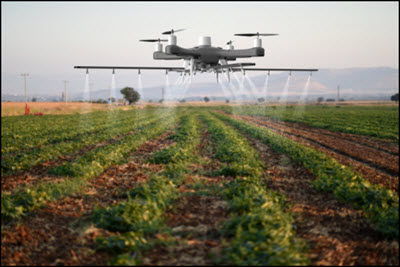How Automation & AI Complement One Another In The Field
The terms Artificial Intelligence (AI) and Automation are often used interchangeably. They’re both, afterall, associated with software or physical machines (that is, robots) that allow us to operate more efficiently within the workplace. The implementation of AI and automation has made waves in many industries, including manufacturing, healthcare and finance and will soon find themselves nestled well within consumer reach. It’s important to note, however, that there are striking and significant differences between AI and automation, especially where complexity levels are concerned.

It’s often understood that while automation is software that follows pre-programmed rules, AI is designed to simulate human thinking.
It’s no secret, however, that both AI and automation are being used in conjunction to complement each system’s strong suits to revolutionize businesses across industries. Find out below more about the applications of AI and automation, respectively and how they can be used to work in tandem.
Current Applications of AI
AI combined with machine learning (ML) have a rapidly growing presence in today’s world. Their applications span industries and they have been used to innovate work in manufacturing to education; streamlining to informing better decision making. There are a number of industries currently experimenting with AI and ML, including:
- Cyber-security: AI is quickly being used to improve the cyber-resilience of many companies by introducing complex reasoning and self-learning in an automated fashion on a huge scale.
- DevOps and Cloud Hosting: Amazon has recently introduced ML for their Elastic Compute Cloud (EC2), which applies to predictive instance auto-scaling. This has paved the way for many other cloud vendors to follow suit.
- Manufacturing: AI has revolutionized the world of manufacturing in tandem with automation by enabling more efficient work with fewer errors. Large companies, such as Microsoft, and smaller companies, such as AtBot, alike have leveraged the power of AI.
- Healthcare: There are a number of AI applications within the healthcare industry including: Computer vision against X-rays shows promises to help pinpoint diseases; natural language processing (NLP) shows promises in drug safety; ML shows promises to find patterns within a population.
- Retail: Retailers will use augmented and virtual reality functionality in advertising. Immersive product catalog visualization will grow dramatically, and shoppers will experience products before buying.
- City Planning: AI can be used to process and organize data for urban areas to document how they’re changing, and provide alternate solutions for development, utility and safety.
- Education: AI can be used to create personalized, dynamic and effective learning strategies for any students to help them achieve success.
- Fashion: Retailers and fashion houses can use AI to assess buying patterns of consumers worldwide and predict upcoming fashion trends.
There are myriad applications for AI and ML across industries, the trick is using human ingenuity and innovation to leverage their applications.
Current Applications of Automation
Undoubtedly, there are many industries that have directly benefited from the implementation of automation to bolster their efficiency, quality of work and productivity. Among these applications include:
- Automotive: Perhaps the largest and most notable beneficiary of automation is the automotive sector. For decades, this industry has implemented automation applications into their factories to deal with labour shortages, improve efficiency and bolster productivity. Working alongside their human counterparts, these automated robots have helped huge companies, such as General Motors, bounce back from recessions and downturns in the market.
- Electronics Manufacturing: As the demand for the latest smartphone, TV and other gadgets technology soars, so too must supply. In order to keep up, many electronics manufacturers have implemented robotic automation to meet their consumers’ demands.
- Medical: Robots are being used across the medical field to assist with the transport of supplies and medication and to help surgeons perform operations.
- Welding: Similar to the automotive industry, many welding companies have deployed robots to recover from labour shortages and add precision to their work. Notably, the company, Onken, has seen much success in their robot implementation.
- Food Service: The use of robots has been especially successful among chain restaurants where patrons expect the same quality and taste around the world. The pizza chain, Little Caesars, for example, has recently patented a robotic arm that spreads dough, add toppings and places pizzas in the oven.
- Law Enforcement: A product of the military-industrial complex, robots have been deployed within local law enforcement to diffuse bombs, gather intel on high-risk situations and report back to their human counterparts. Robots have also been used to take on neighbourhood watch duties and report their insight back to fellow officers.
The Convergence of AI & Automation
While the implementation of automation and AI on their own has revolutionized the way many companies do business and respond to consumer demands, imagine how much more powerful and agile they could be if they married these two systems. While still in the early stages, there are two important and emergencing trends that speak to the convergence of AI and automation.
- Convergence with other technologies: This past year has seen AI combine with other technologies, such as the IoT, ERP ( enterprise resource planning) solutions, blockchain and analytics. An example of this is the combination of AI with data from IoT sensors within a warehouse and how this can be used to improve supply chain management. Leveraging AI to synthesize data from sensors across a business could potentially aid in data-driven decisions, which ultimately improve the bottom line.
- RPA, AI and ML: The marriage between robotic process automation (RPA), AI and ML could spell the future of success for many enterprises. Currently, RPA is driven by highly-repetitive tasks based upon rules that are programmed by humans. As we further explore the relationship between these three systems, AI and ML can allow for RPA to handle more complex, less repetitive tasks, as well as moderate behavioural changes and recognize patterns. Undoubtedly, this combination of systems will increasingly boost the value of RPA.
As automation and AI continue to permeate across industries, and as we continue along the trend of using these systems to complement one another, the limits to what we can achieve are nonexistent. While the point of these systems is to lessen the workload for their human counterparts in some ways, they are inevitably predicated upon human ingenuity, innovation and programming. Understanding this, the need for robotics technicians is on the rise. Should you be interested in kickstarting an exciting career in this field, or supplementing your existing knowledge, our Automation Technician Training Program is a great place to start.
